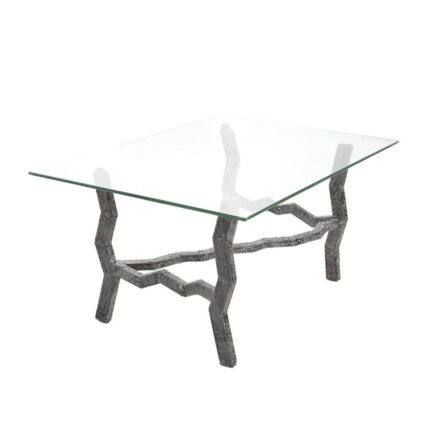“The ebony antique table features the Empire style of the period of King Napoleon III. The Empire style of Napoleon III is marked by grandeur, powerful effects, lavish decoration but not too much.
The Empire style evokes a strong and extremely imposing feeling, which is different from the Rococo style that always celebrates flowery curves. This Napoleon III French antique table is crafted from ebony and decorated with classically symmetrical motifs. The console table becomes especially luxurious and majestic by the strong contrast between the black of the ebony and the gold of the gilt bronze. The plane of the table has an oval shape combined with a rectangle.
The carved motifs on the console table have a classic style. Typically, the acanthus leaf motif is symmetrically printed on the connection of the four bottom bases of the table together. A shapely serpentine X-stretcher merges in the center with a large circle.
The four bases of the antique table are all-round, but the top takes advantage of the angularity of rectangles and squares.
This antique table lacquer has two rectangular drawers. The outside of the two drawers has a floral print and symmetrical acanthus leaf pattern. The acanthus motif is carved on the outside of the drawer and the four sides of the table baluster legs.
The acanthus leaf and its criss-cross curves form a typical symbol. In addition to the acanthus motif, the four sides of the table baluster legs are carved with gilt bronze seashells. In the middle next to the French table is the symbol of the image “”The king” with acanthus leaves on top. “The king” represents Napoleon III by his great strength and resounding feats.
In addition, in addition to the motifs inlaid with ormolu, many motifs are decorated with extremely expensive lacquer. Lacquer not only helps enhance the gloss of the antique table but also helps to increase the life of the table. Lacquer contains shellac solution in alcohol to help the surface become glossy, highly aesthetic, and resistant to corrosion by termites or harmful insects.”
The Empire style evokes a strong and extremely imposing feeling, which is different from the Rococo style that always celebrates flowery curves. This Napoleon III French antique table is crafted from ebony and decorated with classically symmetrical motifs. The console table becomes especially luxurious and majestic by the strong contrast between the black of the ebony and the gold of the gilt bronze. The plane of the table has an oval shape combined with a rectangle.
The carved motifs on the console table have a classic style. Typically, the acanthus leaf motif is symmetrically printed on the connection of the four bottom bases of the table together. A shapely serpentine X-stretcher merges in the center with a large circle.
The four bases of the antique table are all-round, but the top takes advantage of the angularity of rectangles and squares.
This antique table lacquer has two rectangular drawers. The outside of the two drawers has a floral print and symmetrical acanthus leaf pattern. The acanthus motif is carved on the outside of the drawer and the four sides of the table baluster legs.
The acanthus leaf and its criss-cross curves form a typical symbol. In addition to the acanthus motif, the four sides of the table baluster legs are carved with gilt bronze seashells. In the middle next to the French table is the symbol of the image “”The king” with acanthus leaves on top. “The king” represents Napoleon III by his great strength and resounding feats.
In addition, in addition to the motifs inlaid with ormolu, many motifs are decorated with extremely expensive lacquer. Lacquer not only helps enhance the gloss of the antique table but also helps to increase the life of the table. Lacquer contains shellac solution in alcohol to help the surface become glossy, highly aesthetic, and resistant to corrosion by termites or harmful insects.”
-
Dimensions:Height: 29.34 in (74.5 cm)Width: 57.88 in (147 cm)Depth: 31.89 in (81 cm)
-
Style:Napoleon III(In the Style Of)
-
Materials and Techniques:Ebony
-
Place of Origin:France
-
Period:19th Century
-
Date of Manufacture:1860/80
-
Condition:GoodRepaired.
-
Seller Location:Warsaw, PL
-
Reference Number:Seller: LU5826225165952
Reviews (0)






















































Reviews
There are no reviews yet.